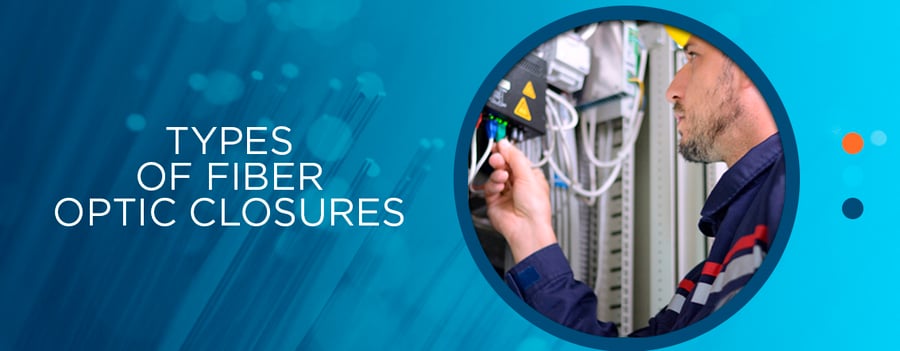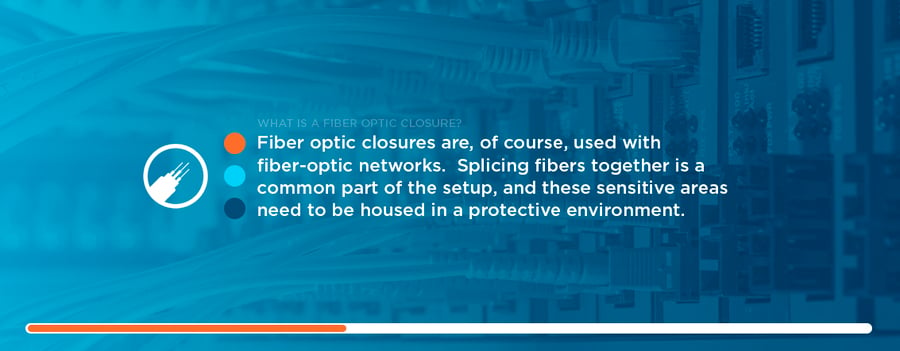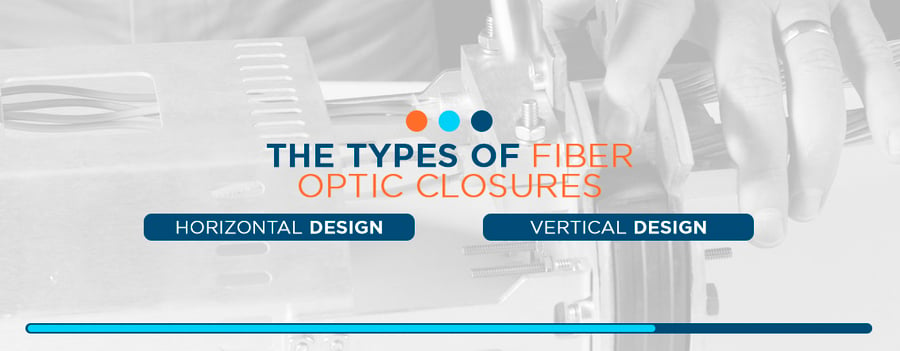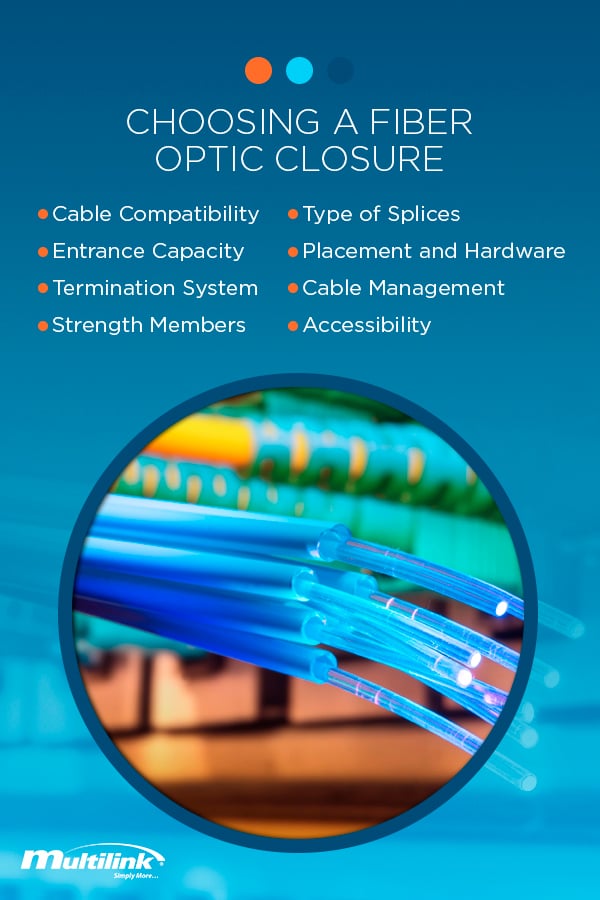{{ quickViewProduct.product_title }}
Stock ID
{{ quickViewProduct.product_stock_number }}
Product Features:
- {{ feature.product_feature_description }}
{{ option.product_option_title }}
{{ value.product_option_value_title }}

Fiber optic cables offer impressive networking capabilities over long distances. These remarkable cables can power phone networks, CATV, LANs, premises networks and more. That means that you can find them in many locations. Fiber optic cabling can run underground, over aerial wiring and even in submarine applications. It spans continents and climates, so cables can be exposed to conditions that are dry, rocky, snowy, wet, dusty, hot and almost any other environment you can think of. So how do we protect these cables from the harsh realities of Mother Nature? That's where fiber optic closures come in.
Fiber optic splice closures are small boxes made of rugged plastics that hold some of the more sensitive areas of cabling and protect them from the elements. As fiber optic networks grow and adapt, these closures have, too. The features that they need to have include ease of accessibility, multiple placement options and the capability to handle different splice types and strength members. Fiber optic enclosures have an important job to do. Knowing more about the basics of fiber optic splice closures can help you choose the right one and minimize project setbacks when setting up networking.

Fiber optic closures are, of course, used with fiber-optic networks. Splicing fibers together is a common part of the setup, and these sensitive areas need to be housed in a protective environment. Fiber optic closures fill that need. Also called fiber optic splice closures, these little boxes provide a protected area for the spliced sections to live, keeping them away from any hazards. Some of the dangers that face the fibers include pressure, extreme temperatures, insects and moisture. Any of these that come in contact with the fiber cables can lead to damage. Bugs may bite through the protective layers, while moisture can flood the cabling. Even things like vandalism and damage from car accidents can be troublesome. A rugged, hermetically sealed fiber optic splice closure can better protect cables and the sensitive data that runs through them from many of the dangers they face.
A fiber optic closure needs to meet strict demands for this level of protection. It must have:
Most splice enclosure types are made with high-strength plastic or stainless steel, with structures designed for easy installation. Design types can vary and offer options for placement in an outside plant or indoor building, with aerial and direct-bury approaches. A hybrid fiber enclosure is designed to suit both above and below-grade applications.
Fiber-optic networks can be complex, with many branches and purposes. Different parts of the network will have unique requirements to allow for appropriate access and functionality. For instance, at the start of the network distribution system, repeated access is typically not much of a concern, and a long-lasting, durable enclosure that doesn't need to be checked regularly is ideal. You may not need to focus as much on accessibility features. As you reach the distribution stage and drop lines, adding more network connections is common, so re-entry is needed. Therefore, it's important to consider in which part of the network your closure will be going and what your concerns are. Flexibility in terms of fiber access and management is also helpful. Hinges on some splice tray setups can cause sharp bends in the cables. In high-capacity closures, this may lead to undue stress, so designs that avoid this could be beneficial.
When choosing a fiber optic closure, it's useful to remember the characteristics of fiber optic cables that can influence certain design components of the closure. Fiber optic cables rely on the passage of light through the cable. No matter how good your closure design is, it can't solve the problem of dust and dirt that accumulate in a connection during splicing. Only experienced installation and a careful hand can do that. Keeping optical losses to a minimum is critical for ideal functioning. Only an experienced technician should install fiber optic closures.
There are three main types of fiber optic closures, intended for different placement options. Both types of closures can have a lot of variation in terms of trays and capacities, but they use similar materials like durable plastics and protective mechanisms such as seals made of gels, gaskets or pull-and-shrink tubing.

The horizontal design is the most common option, probably because it is so versatile. This type of box is fairly flat or cylindrical in shape. It can be mounted aerially or buried underground. A horizontal closure can have various capacities, with some much higher than others. A standard, normal-capacity closure can have several splice trays, which have their own differing capacities for the number of cables they can handle. Of course, higher-capacity closures can fit many more. Common numbers for tray capacities include 12 and 24. Though designs and dimensions can vary, most horizontal boxes will follow similar specifications.
However it looks, a horizontal box needs to be waterproof, dustproof and have good resistance to compression. If attached to a pole or hung from wiring, these closures need to be held firmly in place, to avoid damage from weather and wind.
This design has a domed shape and is intended for buried applications, though you can use many of them above-ground as well. These closures can again take on several different configurations and capacities, with high-capacity versions and variations in the number of trays. They can also vary in the number of inlet and outlet ports available, to match the cable capacity. Reentry may or may not be critical, depending on the closure's placement, but some boxes are designed for easier re-entry than others.
Again, the vertical designs need to retain protection from the elements. Seals and waterproof technology are especially important. These are often used underground, where those dangers are prevalent and can pose serious risks to the cabling inside. Keeping insects and dirt out is particularly important for underground closures.
The hybrid fiber enclosure is capable of securing network fiber regardless of weather, temperature, or location making it the most versatile of the enclosures. This flexibility allows for wall, aerial, or cell installations. In addition, a compact design allows for pedestal mounting and below-grade applications. Adaptability is another benefit to the hybrid enclosure with grommets to suit a 48 count feeder cable (72 count max) and up to 12 Flat, Round, ROC®, or Speedflex™ drop fibers. The unit allows for grounding and can be pressurized if required.
Given the variety of potential mounting locations for the hybrid fiber enclosure, it is designed to IP68 rating and can withstand dust, dirt, sand, and is water-resistant.
When it's time to select your fiber optic closure, you'll face several decisions regarding the characteristics of the closure, the environment it will be placed in and its configurations. Consider the following aspects of your fiber optic system when choosing a closure.

Of course, having the right cable for the right closure is a necessity. Be sure to check the compatibility of your fiber optic cabling and the closure beforehand. Remember that there is a reason for different designs depending on placement and capacity. Knowing your use before selecting a fiber optic closure can help save a lot of time by identifying cable types, adapters, additional hardware and more before you get to the field. You can also make things easier on yourself by opting for universal designs that can integrate with products from other manufacturers or a hybrid fiber enclosure that offers interchangeable grommets to allow for varying fiber counts and types of drops. Doing this can reduce the amount of compatibility you'll need to worry about.
The entrance capacity of a fiber optic closure refers to the number of cable ports it has. The number of ports, of course, is related to the number of cables the closure can handle, which in turn relies on the capacity of the network. The size of these ports can also vary, and some manufacturers will reduce the size of the ports for the branch and drop cables. This approach helps to minimize the physical size of the box since these cables are smaller.
The cable termination system needs to offer enough mechanical strength to support the behavior of the cable during handling and environmental influences. The connection between the cable and closure must use materials that can stand up to the effects of relative motion between the cable components. Optical fiber coatings are typically made with UV-curable resins, which are prone to thermal expansion and contraction under heat. The termination system should be able to handle these changes without stressing the cable.
If you have additional strength members, you'll want to make sure they are securely in place in the closure. Most closures will have a clamping mechanism to keep them in place, but the closure's material also helps it to manage thermal expansion and the differences that it causes to the sheath and strength member. Keeping the strength members terminated close to the cable opening and tying it to the sheath can also help to manage the effects of thermal expansion and stress. Another vital component of working with strength members is their bonding and grounding characteristics. For conductive elements, you'll need to make sure that they are properly bonded and grounded for accurate functioning. The closure's clamping mechanism will help prevent these parts from pulling out during handling.
The splice trays may hold fewer cables if the cables aren't fusion-spliced. Ribbon or mechanical splices can cause you to lose capacity within the closure trays since they are physically larger. These trays should always hold the splice securely and offer a protective cover between it and other trays in the stack. The configuration of your splices can help improve performance. While the type of splice may limit the number of cables you can use, it shouldn't twist or otherwise stress any of the fibers.
Consider the placement of the closure and any additional hardware you may need. If you'll be situating the closure aerially, such as hanging it via messenger wire, you'll need the appropriate tools, and the same applies to underground applications. These extra tools will also need to resist environmental hazards, just like the closure itself. Wind, dust, dirt, moisture and pressure are all concerns that can severely damage a cable system. Whether you're working in the air or on the ground, you'll need to keep the location of the closure as sturdy as possible. A hybrid fiber enclosure is designed to meet the standards for both aerial and below-grade applications.
One concern when working with cables in such tight quarters is keeping the bend radius low. Ignoring this could add undue stress to the cables and impede performance. A fiber optic closure can support cable management methods by offering a design that doesn't require making tight bends to move trays, access cables and move the closure itself. Some designs are more supportive of this than others. Closures that allow for easier installation can also help eliminate excessive stress or damage that could occur during handling.
Difficulty installing and accessing closures used to be a problem, but modern options are much more flexible. Remember that different points in the fiber optic network architecture may require reentry more or less frequently. Some designs are easier to re-access than others. If you need something that can be opened and closed more often, look for one that mentions this capability in the design specs. Consider the expected growth of your fiber-optic network. You may also want to review what kinds of tools are needed to access the box. Sometimes they need specialized sealing tape or C-cement. Preferably, the closure can open and close with the use of basic tools.
Another aspect of accessibility is locking mechanisms. To keep out unauthorized users, many providers opt for closures with locks in them.
Keeping all of these features in mind about fiber optic closures, you should have an idea of what kind you need for your next project. It will need to be rugged, with an effective sealing mechanism. It will also need to have all the features that your networking job requires, whether that is a design built for underground use, easy re-entry, a high capacity for splice trays or something else.
Sometimes, finding a fiber optic splice closure with everything you need is a bit of a challenge. Thankfully, Multilink offers a wide variety of styles with plenty of customization options. Whether you need to add more splice trays, change the mounting style or make some other change to the configuration, Multilink can do it. With our fiber optic splice closures, you can select features like adapter types, mounting method, grommet styles and much, much more, depending on the product. We design our closures with fast installation and easy re-entry in mind, and they are compatible with many universal parts to make for a smooth setup.
We've been working with cables since 1983 and have maintained rigorous standards for quality throughout the years. When you partner with Multilink, you're partnering with experts who take an all-encompassing approach to manufacturing procedures and help our customers in a wide variety of industries and applications. Customization is one of our specialties, allowing us to meet an array of specifications. For more information on receiving a customized product, reach out to one of our representatives today. If you're in need of fiber optic splice closures, take a look at our selection and see how Multilink puts innovation into every single product.
Back to Multilog